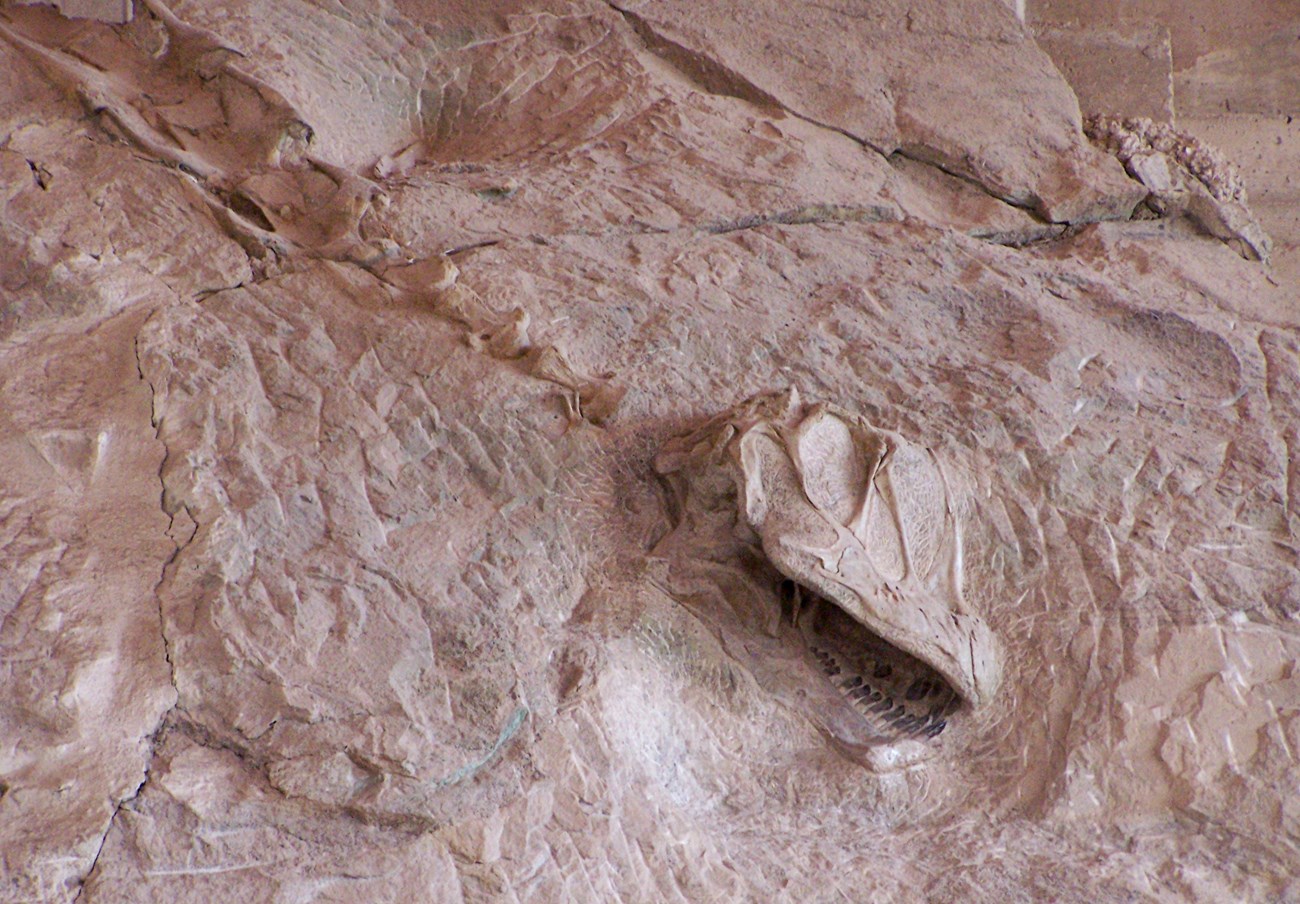Part of a series of articles titled Geologic Time Periods in the Mesozoic Era.
Article
Jurassic Period—201.3 to 145.0 MYA

NPS image
Introduction
Alexander von Humboldt, a German pioneer geologist, first coined this term “Jurassic” in 1795 for the strata of the Jura Mountains in northern Switzerland. In 1839 Leopold von Buch redefined the Jurassic as a system in its own right (Eicher 1976).
Significant Jurassic events
The Jurassic Period was a golden time for dinosaurs, which flourished for 180 million years. Huge sauropod herbivores (such as 87-foot [27-meter] long Diplodocus) and carnivores (such as 35-foot [11-meter] long Allosaurus) emerged. To get a sense of how large these animals were, imagine sprinting as fast as you can. Let’s say you can do the 100-meter dash in 14 seconds. To do the “Diplodocus dash” (head to foot) would take you four seconds. Good thing they weren’t carnivores! However, carnivorous dinosaurs also diversified during the Jurassic. Moreover, the oldest known fossil of a bird is from the Jurassic. Carnivorous dinosaurs such as T. rex and birds descended from the same group—Theropoda.
Learn more about events in the Jurassic Period
The term “dinosaur” was invented by Sir Richard Owen in 1842 to describe these “terrible lizards,” specifically Megalosaurus, Iguanodon, and Hylaeosaurus, the only three dinosaurs known at the time. Since Owen’s time, further data show that dinosaurs were animals that evolved into many sizes and shapes. Modern research has disproved the old concept that dinosaurs were slow-moving, dim-witted, solitary creatures, forced to wade about in swamps because their great bulk could not be supported on land. In fact, many dinosaurs were very agile (even the large ones). Many species apparently roamed the land easily despite their size, and some were quite social, traveling in herds, building nests, and caring for their young (Macdougall 1996).
With the discovery of many new species since the 1840s, scientists have divided the Dinosauria into two major groups: the Ornithischia and the Saurischia, with the distinction based on the construction of the pelvis. The ornithischians were “bird hipped” as well as being herbivores, including both bipedal and quadrupedal forms. The saurischians or “lizard hipped,” including carnivorous bipedal forms (e.g., theropods such as Tyrannosaurus) and herbivorous bipedal and quadrupedal forms (e.g., sauropods). Some of the quadrupedal saurischians developed into the largest land animals in history, including Diplodocus (perhaps reaching lengths of 100 feet [30 m] or more) and Brachiosaurus (perhaps weighing as much as 130,000 pounds [60,000 kg]).
In 1888 H. G. Seeley introduced the division between the two groups. The etymology behind the two names (“bird hipped” vs. “lizard hipped”) is not very accurate, however, as some saurischians (lizards-hipped dinosaurs) actually had bird-like hips. To make matters more confusing, you might think that birds descended from ornithischians because “ornith” (as in ornithologist) means bird. However, birds are descendants of saurischians, specifically theropods.
Birds and pterosaurs serve as an example of a common theme in evolution, the parallel development of different types of body structures and function for the same reason, in this case for flight. The evolution of flight led to generally light and fragile skeletons, so not surprisingly, avian fossils are uncommon, and when found, often fragmentary.
Most paleontologists are convinced that birds evolved from dinosaurs, in particular from theropods. This well-substantiated scientific idea was born with the discovery of a 150-million-year-old (Late Jurassic) fossil bird, Archaeopteryx, which was first described by Richard Owen in 1863 (Owen 1863). The fossil has the skull, teeth, and bony tail of a reptile and (the amazing part of the discovery) a fine-boned skeleton and delicate impressions of feathers—clearly a bird! More recently, beginning in the 1990s, farmers in the north-eastern Chinese province of Liaoning have unearthed skeletons of several kinds of small dinosaurs and primitive birds. The bird-like dinosaurs and dinosaur-like birds were found near the villages of Jianshangou and Sihetun in rocks between 125 and 120 million years old.
Understanding Dinosaur Groups
Here are some brief descriptions the dinosaur groups—Ornithischia and Saurischia—from the Museum of Paleontology at the University of California–Berkeley that might help you keep the systematics of the Dinosaura straight:
Saurischia (“lizard-hipped” dinosaurs) contains two main groups:
- Sauropodomorpha includes both the “prosauropods” and the Sauropoda. Prosauropods were probably a paraphyletic (artificial) group of largely herbivorous, dominantly bipedal dinosaurs such as Plateosaurus. The Sauropoda were long-necked, long-tailed, enormous herbivorous dinosaurs such as Brachiosaurus, Diplodocus, and Apatosaurus.
- Theropoda consists of the carnivorous dinosaurs. The Theropoda includes some extinct dinosaurs such as Tyrannosaurus rex and Dilophosaurus. Birds descended from Theropoda.
Ornithischia (“bird-hipped” dinosaurs) contains three primary groups:
- Thyreophora includes the various armored dinosaurs such as Stegosaurus and Ankylosaurus.
- Marginocephalia consists mainly of the pachycephalosaurs (bone heads) and the ceratopsians (horned dinosaurs) such as Triceratops.
- Ornithopoda includes not only small bipedal plant eaters like Hypsilophodon but also the often large hadrosaurs (duck-billed dinosaurs) like Maiasaura and Edmontosaurus.
Visit—Jurassic Parks
Every park contains some slice of geologic time. Here we highlight a few parks associated with Jurassic Period. This is not to say that a particular park has only rocks from the specified period. Rather, rocks in selected parks exemplify a certain event or preserve fossils or rocks from a certain geologic age.
-
Arches National Park (ARCH), Utah—[ARCH Geodiversity Atlas] [ARCH Park Home] [ARCH npshistory.com]
-
Dinosaur National Monument (DINO), Colorado & Utah—[DINO Geodiversity Atlas] [DINO Park Home] [DINO npshistory.com]
-
Katmai National Park (KATM), Alaska—[KATM Geodiversity Atlas] [KATM Park Home] [KATM npshistory.com]
-
Lake Clark National Park (LACL), Alaska—[LACL Geodiversity Atlas] [LACL Park Home] [LACL npshistory.com]
-
Rainbow Bridge National Monument (RABR), Utah—[RABR Geodiversity Atlas] [RABR Park Home] [RABR npshistory.com]
-
Wrangell-St. Elias National Park and Preserve (WRST), Alaska—[WRST Geodiversity Atlas] [WRST Park Home] [WRST npshistory.com]
More about the Mesozoic
►
Last updated: April 27, 2023

